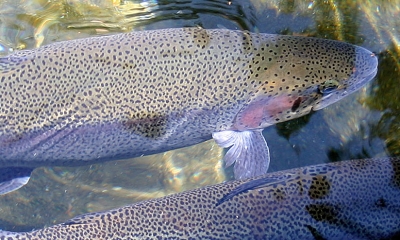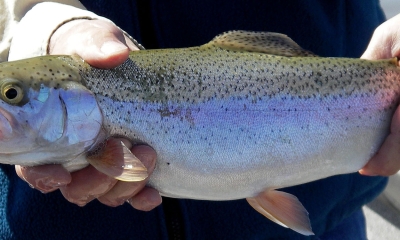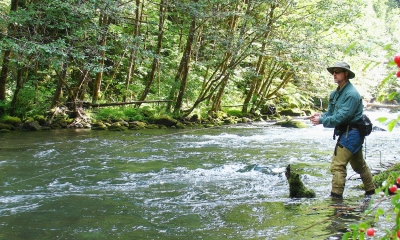
Rainbow trout
Rainbow trout are coldwater fish that have long been symbolic of clear, healthy mountain streams and lakes in North America.

Types of Rainbow trout

Features: Coastal rainbow trout are often residualized steelhead that spend their entire life cycle in fresh water, never migrating to sea. They are a silvery color with black spots on their backs and fins, and a pink band running down their sides. Often their gill covers are pink as well. The pelvic anal, and dorsal fins have a white edge to them.
Habitat: They can be found in cold rivers, creeks, and inland lakes. However, they require streams with clean gravel, complex habitat, and cool temperatures for spawning and rearing.
Techniques: Trout in stillwaters tend to be on the move, “cruising” the water looking for food. Suspending bait under a bobber is a good way to fish for these trout. Start with a piece of worm or a little PowerBait or similar product on a bait hook. Attach a small lead weight just above the hook to help the bait sink, and add a bobber 1 ½ to 3 feet above the hook.
In moving waters, trout like to hold in one spot and wait for the water current to bring food to them. A primary food source for these fish is aquatic insects adrift in the current. Fish for these trout by casting a spinner or spoon slightly up river and reeling in any slack line. As the current carries the spinner down river, hold as much fishing line off the water as you can to achieve a natural “drift.” Once the spinner has swung toward the shore and is straight down river, begin a moderate retrieve.

Features: The color of all trout varies with environment. In general, the rainbow is bluish-green on the back, silvery on the sides and belly, and has a white edge to the dorsal, anal, and pelvic fins. A generous sprinkling of black spots appear along the back, and on the dorsal, adipose and caudal fins. A pinkish band usually extends along the sides.
Habitat: Rainbow trout are the most widely stocked and distributed trout in Oregon. They occur naturally in many rivers and streams, and each year ODFW stocks millions more in ponds, lakes and streams. Prime trout waters are clear, clean and cold. Good trout stream habitat is complex, consisting of an array of riffles and pools, submerged wood, boulders, undercut banks, and aquatic vegetation. The ability to swim to and from different habitats from ocean to headwaters, or from tributary confluence to headwaters, increases the value of individual habitat components.
Technique: Rainbow trout have a well-earned reputation for being a hardy, hard-fighting game fish. Their diet consists of minnows, crayfish, insects and other small aquatic life, making them susceptible to a well-presented spinner, flatfish or fly. Baits, such as night crawlers and dough bait (like PowerBait), can also be very effective.

Features: As the name suggests, these fish have rosy red strip along their sides. Other identification clues include large, profuse black spots on the body and orange and yellow tints along the belly.
Habitat: Redband trout are a subspecies of native rainbow trout that have adapted to the arid, desert conditions of eastern Oregon. During drought years distribution constricts as streams dry and become uninhabitable. Trout re-colonize these streams during wet cycles, expanding the distribution. Prime trout waters are clear, clean and cold. Good trout stream habitat is complex, consisting of an array of riffles and pools, submerged wood, boulders, undercut banks, and aquatic vegetation.
Technique: Few waters with native redband populations allow the use of bait. Anglers often catch them with artificial flies and lures.

